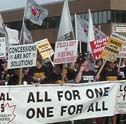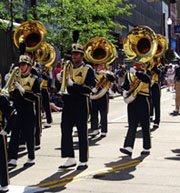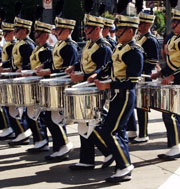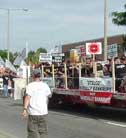Happy Labour Day .. dreaming of the monarchy of majority government in Ottawa
Sep 2nd, 2006 | By Counterweights Editors | Category: Key Current Issues As an official national holiday Labour Day (or Labor Day) will be 112 years old this year, in both Canada and the United States. And as Harold Meyerson has nicely explained in the Washington Post, those who started it in the later 19th century would almost certainly not be too happy about Labour Day 2006. Meanwhile, Greg Weston of the Sun Chain (and particularly the Ottawa Sun) wrote another nice piece about how Stephen Harper is still dreaming of “the monarchy of majority government” in the next Canadian federal election. But then some Canoe News editor apparently decided to remove “the monarchy of” – even though it is a nice touch itself. And you have to wonder why?
As an official national holiday Labour Day (or Labor Day) will be 112 years old this year, in both Canada and the United States. And as Harold Meyerson has nicely explained in the Washington Post, those who started it in the later 19th century would almost certainly not be too happy about Labour Day 2006. Meanwhile, Greg Weston of the Sun Chain (and particularly the Ottawa Sun) wrote another nice piece about how Stephen Harper is still dreaming of “the monarchy of majority government” in the next Canadian federal election. But then some Canoe News editor apparently decided to remove “the monarchy of” – even though it is a nice touch itself. And you have to wonder why?
1. Another Canadian non-debate: Who started Labour/Labor Day … ?
 Who started Labour/Labor Day in North America anyway? According to the Canadian Encyclopedia online, a Toronto printers’ strike for a shorter work week in the 1870s spawned the first modern labour parades in that city. Then: “The fight of the Toronto printers had a second, lasting legacy. The parades … led to an annual celebration. In 1882 American labour leader Peter J. McGuire witnessed one of these labour festivals in Toronto. Inspired, he returned to New York and organized the first American labour day’ on September 5 of the same year.”
Who started Labour/Labor Day in North America anyway? According to the Canadian Encyclopedia online, a Toronto printers’ strike for a shorter work week in the 1870s spawned the first modern labour parades in that city. Then: “The fight of the Toronto printers had a second, lasting legacy. The parades … led to an annual celebration. In 1882 American labour leader Peter J. McGuire witnessed one of these labour festivals in Toronto. Inspired, he returned to New York and organized the first American labour day’ on September 5 of the same year.”
On the other hand, according to the US Department of Labor: “there is still some doubt as to who first proposed the holiday for workers … Some records show that Peter J. McGuire, general secretary of the Brotherhood of Carpenters and Joiners and a cofounder of the American Federation of Labor, was first in suggesting a day to honor those who from rude nature have delved and carved all the grandeur we behold.’ …
“But Peter McGuire’s place in Labor Day history has not gone unchallenged. Many believe that Matthew Maguire, a machinist, not Peter McGuire, founded the holiday. Recent research seems to support the contention that Matthew Maguire, later the secretary of Local 344 of the International Association of Machinists in Paterson, N.J., proposed the holiday in 1882 while serving as secretary of the Central Labor Union in New York. What is clear is that the Central Labor Union adopted a Labor Day proposal and appointed a committee to plan a demonstration and picnic.”
 Both these stories could of course be more or less true at the same time. Both Matthew and Peter Maguire may have contributed to the consensual historical fact that the “first Labor Day holiday” in the US “was celebrated … in New York City” in September 1882. And Peter Maguire’s part in this historical drama may have been inspired by an earlier visit to Toronto (the traditional Canadian outpost of New York City, stretching back to the 17th century) in the same year.
Both these stories could of course be more or less true at the same time. Both Matthew and Peter Maguire may have contributed to the consensual historical fact that the “first Labor Day holiday” in the US “was celebrated … in New York City” in September 1882. And Peter Maguire’s part in this historical drama may have been inspired by an earlier visit to Toronto (the traditional Canadian outpost of New York City, stretching back to the 17th century) in the same year.
In the style of History Detectives on PBS, it would take further research to nail all the boards down tightly. Is there some documentation, e.g., on Peter Maguire’s supposed visit to Toronto earlier in the summer of 1882? Is there any evidence that Matthew Maguire and Peter Maguire ever communicated with each other during the summer of 1882? What was Peter Maguire’s relationship with the Central Labor Union? Etc.
But the best altogether decisive answer to all this is almost certainly who really cares? The final and official “national” stories are remarkably similar. And as any sensible person would expect, it was the elephant and not the mouse that roars who led the way.
 So in many different parts of both Canada and the United States more or less official local and regional celebrations of “Labour Day/Labor Day” became increasingly prevalent in the later 19th century. Then, according to the US Department of Labor: “By 1894 [a total of 31] states had adopted the holiday in honor of workers, and on June 28 of that year, Congress passed an act making the first Monday in September of each year a legal holiday in the District of Columbia and the territories.”
So in many different parts of both Canada and the United States more or less official local and regional celebrations of “Labour Day/Labor Day” became increasingly prevalent in the later 19th century. Then, according to the US Department of Labor: “By 1894 [a total of 31] states had adopted the holiday in honor of workers, and on June 28 of that year, Congress passed an act making the first Monday in September of each year a legal holiday in the District of Columbia and the territories.”
Then, according to the Canadian Encyclopedia online: “Throughout the 1880s pressure built in Canada to declare a national labour holiday and on July 23, 1894 the government of Sir John Thompson passed a law making Labour Day official. A huge Labour Day parade took place in Winnipeg that year. It stretched some 5 kilometres.”
2. Labour/Labor movements in Canada and the United States today …
 Along with Harold Meyerson’s nice piece in the Washington Post, a report in the Los Angeles Times called “Middle-Class Workers Ailing in Census Checkup,” by Joel Havemann and Ricardo Alonso-Zaldivar, nicely documents the sorry enough state of both labor and the traditional labor movement in the USA today.
Along with Harold Meyerson’s nice piece in the Washington Post, a report in the Los Angeles Times called “Middle-Class Workers Ailing in Census Checkup,” by Joel Havemann and Ricardo Alonso-Zaldivar, nicely documents the sorry enough state of both labor and the traditional labor movement in the USA today.
(And the concept of “Middle-Class Workers” is an important one in both articles. Meyerson begins with: “Labor Day is almost upon us, and like some of my fellow graybeards, I can, if I concentrate, actually remember what it was that this holiday once celebrated. Something about America being the land of broadly shared prosperity. Something about America being the first nation in human history that had a middle-class majority, where parents had every reason to think their children would fare even better than they had.”)
Some Canadians will want to stress that at least the traditional labour movement is in better shape today in Canada. According to a comparatively recent item on the Net by Elaine Bernard, Executive Director of the Harvard Trade Union Program: “During a time in which Canadian unionization rates have continued to grow to their current level of 37 percent of the workforce, the once-powerful U.S. labor movement has seen its influence decline and the organization rate tumble to 16 percent of the workforce, while wage disparity has dramatically increased and average living standards for working people have fallen.”
 According to a somewhat more recent report from the aggressively private-sector Fraser Institute in Canada: “in 2003, Canada’s unionization rate was much higher (at 32.4 percent of employment) than the United States (at 14.3 percent).”
According to a somewhat more recent report from the aggressively private-sector Fraser Institute in Canada: “in 2003, Canada’s unionization rate was much higher (at 32.4 percent of employment) than the United States (at 14.3 percent).”
Yet even from these quick and dirty numbers unionization rates in both Canada and the United States have been falling lately (from 37% to 32% even in Canada).
And who would doubt that what Harold Meyerson says about the biggest picture in the world at large today does not finally apply to Canada just as much as the United States: “Clearly, globalization has weakened the power of workers and begun to erode the egalitarian policies of the New Deal and social democracy that characterized the advanced industrial world in the second half of the 20th century.”
3. Labour in Canada and the Harper minority government …
 Both Elaine Bernard at Harvard and the Fraser Institute “with offices in Vancouver, Calgary, and Toronto” agree that political activity and the role of government have a lot to do with the relatively greater strength of the labour movement in Canada than in the US today.
Both Elaine Bernard at Harvard and the Fraser Institute “with offices in Vancouver, Calgary, and Toronto” agree that political activity and the role of government have a lot to do with the relatively greater strength of the labour movement in Canada than in the US today.
On Labour Day 2006 this raises the question of just how the labour movement in Canada will finally fare under the current Conservative minority federal government in Ottawa.
On August 30, 2006, e.g., just in time for this year’s Canadian labour festivals, the Fraser Institute released a study arguing that “Unions in Canada must be required to be more transparent and financially accountable to workers.”
The Fraser “study recommends using the US system as a standard for reform.” Mmmm … That would no doubt be one way of bringing current Canadian unionization rates closer to current US rates – and bringing the Canadian labour movement still closer to the lamentable circumstances so nicely described by Mssrs. Meyerson, Havemann, and Alonso-Zaldivar, in the Washington Post and the Los Angeles Times.
 So is this something that is going to be on the legislative agenda of Stephen Harper’s new Government of Canada in Ottawa?
So is this something that is going to be on the legislative agenda of Stephen Harper’s new Government of Canada in Ottawa?
Who knows exactly at the moment, of course? But who can doubt that Mr. Harper’s new Conservative Party of Canada pays more attention to the Fraser Institute than any other political party in the country? (And if you think this does not really apply to the fat-cat Liberals, consider the recent career moves of the Canadian Auto Workers’ Buzz Hargrove – towards the Liberals and away from Jack Layton’s New Democrats, who are currently preoccupied with Canada’s increasingly troubling but inevitably quite modest role in Afghanistan.)
4. More reasons to beware “the monarchy of majority government” in Canada today … ?
 All this lends some extra poignance to Greg Weston’s recent Sun Chain report that “seizing the monarchy of majority government” in the next Canadian federal election remains “this PM’s obsession” – as the non-dithering and hard-working Stephen Harper continues to burn the midnight oil in the official mansion at 24 Sussex Drive, where Margaret Trudeau once allegedly smoked marijuana. (And where the next election might come as early as spring 2007, or even this fall, to almost match the November 7, 2006 mid-term elections in the USA?)
All this lends some extra poignance to Greg Weston’s recent Sun Chain report that “seizing the monarchy of majority government” in the next Canadian federal election remains “this PM’s obsession” – as the non-dithering and hard-working Stephen Harper continues to burn the midnight oil in the official mansion at 24 Sussex Drive, where Margaret Trudeau once allegedly smoked marijuana. (And where the next election might come as early as spring 2007, or even this fall, to almost match the November 7, 2006 mid-term elections in the USA?)
Here the story takes another intriguing zig-zag. According to an apparently earlier version of Greg Weston’s piece, “seizing the monarchy of majority government” in the next federal election remains “this PM’s obsession.” (Note too that this earlier version was headlined “Stephen stalls: Harper has focused his energy on winning enough support for a majority, but an SES-SUN poll shows he’s still right where he started in January.”)
 According to an apparently later version of almost exactly the same piece, the text merely says that “seizing a majority government is this PM’s obsession.” I.e., Mr. Weston’s nicely telling if also somewhat politically charged epithet about “seizing the monarchy of majority government” has been cut by some editor in what is apparently the second version of his piece. (And this version is also somewhat more neutrally headlined “Harper’s minority report: Nothing much has changed on the Canadian political scene, says Greg Weston.”)
According to an apparently later version of almost exactly the same piece, the text merely says that “seizing a majority government is this PM’s obsession.” I.e., Mr. Weston’s nicely telling if also somewhat politically charged epithet about “seizing the monarchy of majority government” has been cut by some editor in what is apparently the second version of his piece. (And this version is also somewhat more neutrally headlined “Harper’s minority report: Nothing much has changed on the Canadian political scene, says Greg Weston.”)
So what, you might say? Editors do such things. That is their job. But this is regrettable, and a sign of one sorry side of political journalism in our time – even in Canada where the traditional labour movement is still stronger, etc. Because a “monarchy” actually is pretty close to what a prime minister of Canada (and most other parliamentary democracies these days) gets, when his or her party is so lucky as to win a majority of seats in the democratically elected parliament.
 What’s more, given Canada’s current electoral system and five-party system of political parties, a party can actually win a majority of seats in the federal Parliament (or Canadian House of Commons) with as little as 40% of the popular vote. Which certainly is not very or even remotely democratic – even if it is the current “rule of law.” (For those who think they can still get away with just technically observing the letter of the law, even when the law is so clearly an ass, as Charles Dickens long ago aptly said it sometimes is.)
What’s more, given Canada’s current electoral system and five-party system of political parties, a party can actually win a majority of seats in the federal Parliament (or Canadian House of Commons) with as little as 40% of the popular vote. Which certainly is not very or even remotely democratic – even if it is the current “rule of law.” (For those who think they can still get away with just technically observing the letter of the law, even when the law is so clearly an ass, as Charles Dickens long ago aptly said it sometimes is.)
In any case, it is the law, for the time being. And while it seems clear enough, at the moment, that Stephen Harper’s new Conservative Party cannot hope to win anything quite like even 51% of the cross-Canada popular vote in any foreseeable federal election, it could conceivably win as much as 40% and inherit the prize of “the monarchy of majority government.” And since early this past February the Toronto-born-and-raised Mr. Harper himself does appear to have hinted very strongly that he almost certainly is an aspiring Canadian monarch of the oldest school, perhaps only superficially leavened by his adult encounter with Western Canadian populism.
 As Greg Weston’s article in both its versions does make clear as well, at the moment the opinion polls on the prospect of Mr. Harper’s actually achieving the monarchy of majority government do not look too good. But late last summer the opinion polls on the prospect that Stephen Harper’s Conservatives could even form a minority federal government did not look too good either. And then look what happened in January 2006?
As Greg Weston’s article in both its versions does make clear as well, at the moment the opinion polls on the prospect of Mr. Harper’s actually achieving the monarchy of majority government do not look too good. But late last summer the opinion polls on the prospect that Stephen Harper’s Conservatives could even form a minority federal government did not look too good either. And then look what happened in January 2006?
So as what remains of the grand old tradition of local Labour Day parades unfolds across Canada this Monday, September 4, it seems a very good bet than many surviving revelers will also be hoping that Greg Weston’s first version of his current prognosis, called “Stephen stalls,” is right on – and continues to be right, all the way up to the next federal election. (Whenever it comes, and whatever may or may not happen with the now increasingly anticipated tricky parliamentary vote on softwood lumber, coming to Parliament Hill in Ottawa all too soon?).

